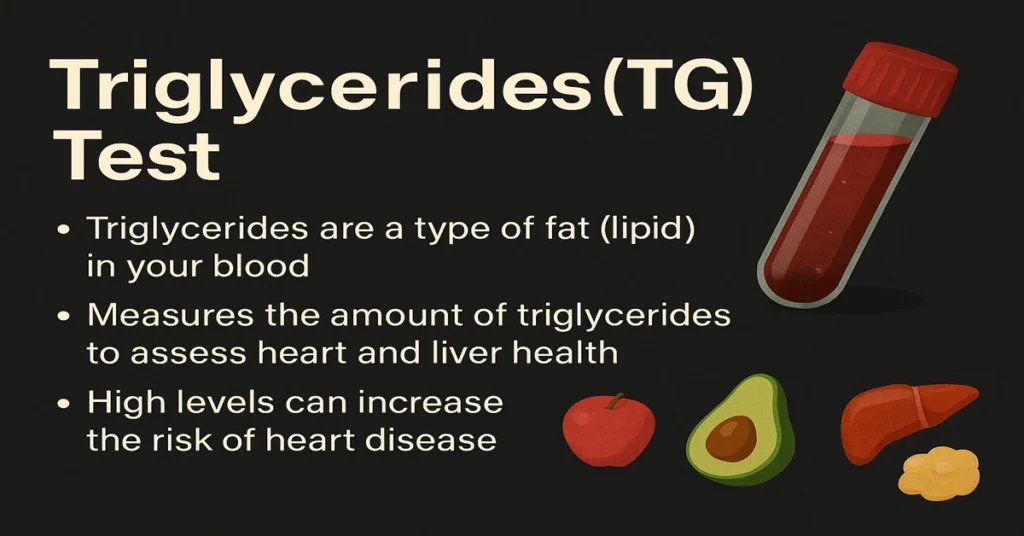What is TG (Triglycerides)?
Triglycerides (TG) are a type of fat (lipid) found in your blood. They are one of the most common forms of energy storage in the human body.
Whenever you eat, your body converts extra calories — especially from carbohydrates and fats — into triglycerides. These are stored in fat cells and released later when the body needs energy between meals or during fasting.
Having normal triglyceride levels is important for energy balance. However, high triglycerides can increase your risk of serious health conditions such as heart disease, stroke, and pancreatitis (inflammation of the pancreas).
On the other hand, extremely low triglyceride levels can indicate problems with nutrition or metabolism.
Where are Triglycerides Produced in the Body?
Triglycerides are made both inside your body and absorbed from your diet.
- Liver: The liver is the main organ responsible for producing triglycerides. It converts excess glucose and carbohydrates into triglycerides and releases them into the bloodstream for storage or energy use.
- Adipose tissue (fat cells): Fat cells also store and release triglycerides depending on your body’s energy needs.
- Dietary sources: Foods rich in fat, sugar, and refined carbohydrates (like sweets, fried foods, and alcohol) contribute directly to triglyceride levels.
Main Functions and Importance of Triglycerides
Triglycerides play several vital roles in maintaining your overall health and energy balance:
- Energy Storage: They act as the body’s main energy reservoir. When your body needs energy, triglycerides are broken down into fatty acids and used as fuel.
- Backup Energy Source: During fasting or when glucose is low, your body depends on stored triglycerides to maintain energy supply.
- Vitamin Transport: Triglycerides help carry fat-soluble vitamins such as Vitamin A, D, E, and K, which are crucial for vision, immunity, and bone health.
- Metabolic Balance: They help regulate metabolism and energy levels between meals.
Although triglycerides are essential for survival, maintaining a balance is critical. Both very high and very low levels can be harmful to your body.
Causes of Low Triglyceride Levels (Hypotriglyceridemia)
Low triglycerides are uncommon and usually not a serious problem. However, they may indicate an underlying health or metabolic issue, such as:
- Hyperthyroidism (overactive thyroid gland) – increases metabolism and lowers triglycerides.
- Malnutrition or low-calorie diet – not enough calories or fats in the diet.
- Malabsorption disorders – conditions like celiac disease or Crohn’s disease can reduce nutrient absorption.
- Chronic liver disease – reduces the liver’s ability to produce triglycerides.
- Certain medications – such as statins or fibrates can lower triglycerides.
- Inherited lipid disorders – genetic conditions affecting fat metabolism.
Symptoms of Low Triglycerides
Most people do not experience symptoms, but if levels are very low, you may notice:
- Unintentional weight loss
- Fatigue or tiredness
- Weakness
- Poor nutrient absorption
Causes of High Triglyceride Levels (Hypertriglyceridemia)
High triglycerides are much more common and a major risk factor for cardiovascular diseases.
Several factors can raise triglyceride levels, including:
- High intake of sugar, fat, or alcohol
- Obesity and sedentary lifestyle
- Uncontrolled diabetes mellitus
- Hypothyroidism (underactive thyroid)
- Kidney or liver disease
- Certain medications: such as steroids, beta-blockers, and oral contraceptives
- Genetic disorders: such as familial hypertriglyceridemia (runs in families)
Symptoms of High Triglycerides
In most cases, high triglycerides do not cause symptoms. However, very high levels may lead to:
- Pancreatitis: severe abdominal pain, nausea, vomiting
- Fatty liver disease
- Xanthomas: small yellow fat deposits on the skin
- Increased risk of heart attack and stroke
Reference (Normal) Ranges
| Triglyceride Level | Result Classification |
|---|---|
| Below 150 mg/dL | Normal |
| 150–199 mg/dL | Borderline High |
| 200–499 mg/dL | High |
| Above 500 mg/dL | Very High |
⚠️ Persistent levels above 200 mg/dL should be evaluated by a doctor to prevent cardiovascular complications.
Sample Type
- Sample Type: Serum
- Tube Used: Red Top (Plain Tube)
- Fasting Required: Yes, usually 9–12 hours before test
Test Preparation
To ensure accurate results:
- Fast for 9–12 hours before the test (only water is allowed).
- Avoid alcohol for at least 24 hours before testing.
- Inform your doctor about medications, as some can affect lipid levels.
- Try to maintain your regular diet in the days leading up to the test — sudden changes can affect readings.
When to Consult a Doctor
Consult your doctor if:
- Your triglyceride level is above 200 mg/dL in repeated tests
- You have a family history of heart disease, diabetes, or obesity
- You experience symptoms like abdominal pain, xanthomas, or chest pain
- You are already diagnosed with diabetes, thyroid disease, or fatty liver — triglyceride monitoring is essential in these cases.
Important Word Explanations
| Term | Meaning |
|---|---|
| Lipid | A type of fat or fat-like substance in the body. |
| Pancreatitis | Inflammation of the pancreas, a gland behind the stomach. |
| Xanthomas | Yellowish cholesterol-rich deposits on the skin. |
| Hypertriglyceridemia | High triglyceride levels in the blood. |
| Hypotriglyceridemia | Low triglyceride levels in the blood. |
~END~

